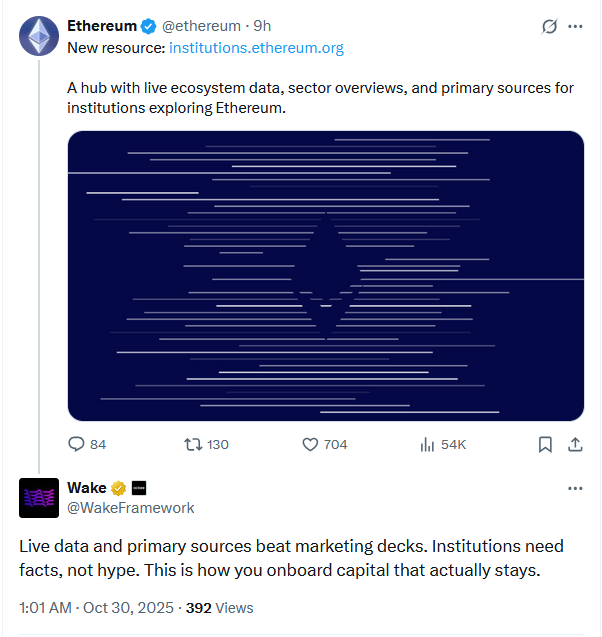The Ethereum Foundation has launched institutions.ethereum.org, a dedicated resource to guide institutions into the Ethereum ecosystem by highlighting enterprise use cases like tokenized real-world assets and DeFi, while showcasing key statistics on Ethereum’s market dominance in these areas.
-
New Ethereum Foundation initiative targets institutional adoption with a streamlined onboarding website.
-
It features sections on digital assets, live data, and institutional insights to support businesses transitioning to blockchain.
-
Ethereum holds 75% of the RWA market, 65% of DeFi TVL, and 60% of stablecoin TVL, underscoring its leadership position.
Ethereum Foundation unveils institutions.ethereum.org to simplify institutional entry into blockchain. Explore use cases, data, and insights for enterprise adoption today.
What is the Ethereum Foundation’s New Institutional Onboarding Resource?
The Ethereum Foundation’s new institutional onboarding resource is a dedicated website called institutions.ethereum.org, launched to assist businesses in transitioning from traditional finance to the Ethereum network. Developed by the Foundation’s Enterprise Acceleration team, it provides clear pathways for institutional adoption by showcasing real-world applications and network strengths. This initiative aims to position Ethereum as the secure base layer for global financial value moving onchain.
How Does the New Website Support Enterprise-Grade Use Cases on Ethereum?
The website features a clean, user-friendly design that highlights key enterprise-grade use cases on Ethereum, including tokenized Real World Assets (RWAs), stablecoins, decentralized finance (DeFi), privacy tools, and layer 2 scaling solutions. It presents compelling data to demonstrate Ethereum’s dominance: the network captures 75% of the total RWA market share, 65% of all DeFi total value locked (TVL), and 60% of stablecoin TVL. These statistics, drawn from onchain analytics, illustrate Ethereum’s robustness and appeal for institutional players.
Institutions already active on Ethereum are spotlighted with specific examples of their contributions. For instance, Visa processes an annual stablecoin volume exceeding $1 billion on the network, BlackRock manages over $1.15 billion in tokenized assets, and Coinbase’s layer 2 solution, Base, supports $15.5 billion in TVL. This section uses verified onchain data to build credibility and encourage similar adoption.
The site is divided into three main areas: “Digital Assets,” offering an overview of blockchain sectors like tokenization and DeFi; “Live Data,” providing real-time metrics on network activity and institutional involvement; and a “Library” with institutional insights from research reports and industry analyses. These resources equip decision-makers with the knowledge needed to integrate Ethereum into their operations effectively.

The launch of this resource reflects the Ethereum Foundation’s ongoing commitment to fostering institutional engagement. By addressing barriers to entry, such as education and visibility, it helps demystify blockchain for enterprises. Experts in the field, including Ethereum developers, emphasize that such tools are crucial for scaling adoption, as noted in Foundation announcements.
Frequently Asked Questions
What Key Features Does Institutions.Ethereum.org Offer for Businesses?
The website provides pathways for institutional onboarding, detailed use cases in areas like RWAs and DeFi, live onchain data, and a library of insights from research and news. It highlights Ethereum’s market leadership with stats like 75% RWA share, making it a one-stop resource for enterprises exploring blockchain integration.
Why Is Ethereum Positioned as the Base Layer for Institutional Finance?
Ethereum serves as a neutral and secure foundation for onchain financial value due to its proven scalability, security, and ecosystem maturity. With major players like Visa and BlackRock already utilizing it for high-volume transactions and asset tokenization, it offers the reliability institutions need for enterprise applications.
The Ethereum Foundation’s efforts extend beyond this launch. Earlier initiatives include Etherealize, a platform to enhance institutional education on Ethereum’s capabilities. In mid-September, the Foundation released a comprehensive roadmap focusing on privacy enhancements, rebranding its “Privacy and Scaling Explorations” to “Privacy Stewards of Ethereum” to introduce end-to-end privacy features.
Additionally, the Foundation established a dedicated AI research team to build a decentralized AI stack for Ethereum. This team aims to create an economy of autonomous agents and bots, positioning Ethereum as the settlement layer for AI-driven applications. As Ethereum Foundation research scientist Davide Crapis explained in a public statement, “Our mission: make Ethereum the preferred settlement and coordination layer for AIs and the machine economy.”
These developments collectively strengthen Ethereum’s appeal to institutions by addressing key needs in privacy, scalability, education, and emerging technologies like AI. The network’s evolution continues to attract global financial value, with institutions increasingly recognizing its potential for secure, efficient operations.
Key Takeaways
- Ethereum’s Market Dominance: The network leads with 75% RWA share, 65% DeFi TVL, and 60% stablecoin TVL, providing a strong foundation for institutional trust.
- Practical Use Cases: Institutions can explore tokenized assets, stablecoins, and layer 2 solutions through showcased examples from leaders like Visa and BlackRock.
- Ongoing Innovations: Recent roadmap updates and AI research initiatives signal Ethereum’s commitment to privacy and future tech integration for enterprises.
Conclusion
The Ethereum Foundation’s launch of institutions.ethereum.org represents a significant step in streamlining institutional onboarding to the Ethereum ecosystem, offering clear guidance on enterprise-grade use cases like RWAs and DeFi. By integrating live data, insights, and examples from major players, it empowers businesses to confidently adopt blockchain technology. As Ethereum continues to evolve with privacy enhancements and AI-focused developments, institutions are well-positioned to leverage its secure infrastructure for the future of finance—explore these resources to stay ahead in the onchain movement.






